Winches do hauling, lowering, or lifting heavy objects by adjusting the load on the motor, powered by the battery. That’s where the solenoid comes into play as a mediator between them to keep things in control.
This part of the winch remains within the machine, giving you control over how much current flows to the motor. Although the winch solenoid performs a great amount of the important roles of the winch machine, it is sometimes bypassed for several reasons.
But, replacing or bypassing a solenoid is never a rush task. There could be a risk of electrical problems or damaging your winch and other electrical components within. Let’s give you some useful tips and help you understand exactly how to bypass the winch solenoid for good.
When Do You Need to Bypass Winch Solenoid?
The solenoid plays a very significant role in the winch motor. One of its sole purposes is to reduce the tension factor on the wire switch and prevent the motor from burning out.
Yes, the effectiveness of the winch solenoid cannot be over-emphasized in cases when you want to use it. But there are situations when you need to bypass its functions and wire the winch without a solenoid.
Here are some of the reasons:
To Forestall Contamination Cases
Winches have a knack for gathering dirt and contaminated substances. Sometimes you will notice the contaminated or dirty release of gases attached to the solenoid. Professionals who know how to handle winches will rightly guess that such conditions are due to an overload or bad exposure. The best action to take would be a fast replacement or removal to avoid further issues which may be more dangerous.
Protect It From Overheating
Avoiding a solenoid at a time like this is advisable. The wiring coil of the solenoid may produce a lot of heat due to a pulse of high inrush current it receives. The current only decreases as the plunger close, and when the plunger does not close, it can cause the coil to overheat and burn out. Overheating is a common problem when solving solenoid failure, and it’s necessary to look out for it.
Troubleshooting
When troubleshooting the winch motor, you can bypass a solenoid to test the functionality of the winch motor. The action of troubleshooting is necessary and needs to be done regularly, especially if you want to rule out issues with the solenoid switch.
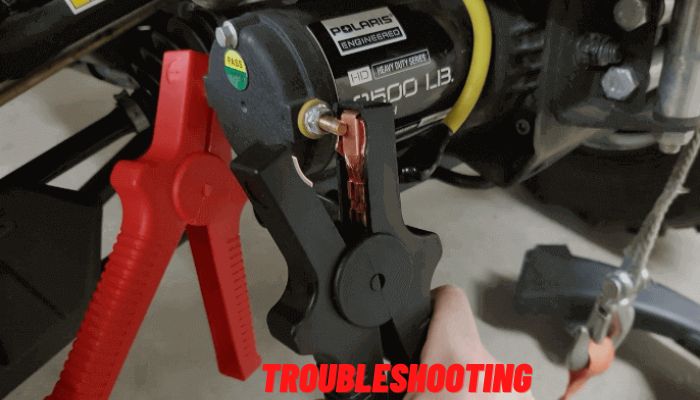
You need to search for the source of the problem and locate it immediately during maintenance. The solenoid is installed on your winch, and the easiest way to get to your winch motor directly is to bypass the solenoid.
To Avoid Mechanical Damage
Mechanical damage can be caused by breakage or the exertion of excessive force on the winch. The excessive force may be due to overvoltage or a reduction in object load, which is then absorbed by the plunger, causing the solenoid to hammer itself to pieces.
Since replacing a solenoid is a lot cheaper than the motor, removing the solenoid is better to prevent the development of secondary issues with your winch system.
It’s better to run your winch motor without a solenoid compared to buying a new 5000-pound winch. Also, remember to determine the cause of the solenoid damage before replacement or bypassing it. Rust, dust, dirt, contaminated gases and untidy battery connections can all contribute to different solenoid problems.
How To Bypass Winch Solenoid In The Easiest Way?
When talking about bypassing the solenoid, the easiest way to achieve it is to wire the winch motor. Winches are naturally designed to push and pull with incredible amounts of force, so we’ll proceed with the necessary safety measures before we discuss how to bypass the winch solenoid.
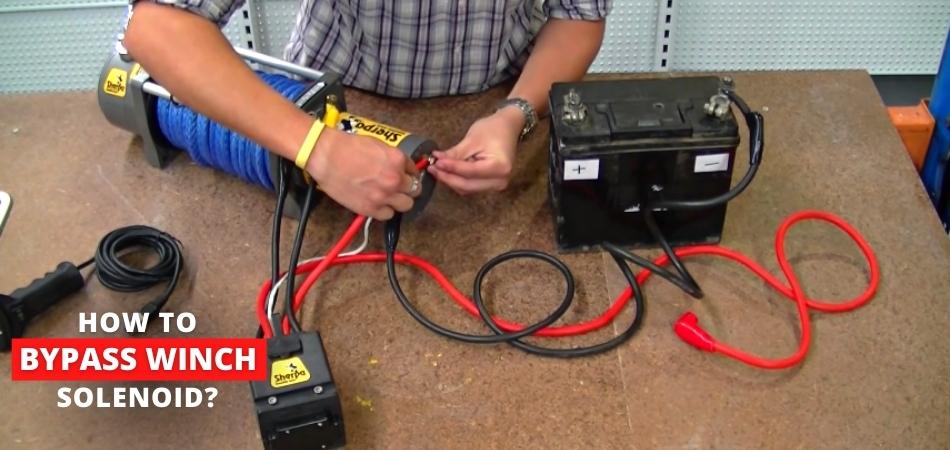
Prepare Your Work Environment
An organized workspace helps you achieve most of your safety measures. Your environment should be free of dirt and stuff that can incur accidents. Water pools should be wiped, and objects that can cause you to trip or slip must be carefully removed. The working area in question is full of electrical wiring, so all possibilities of shock hazards should be avoided.
Get Knowledgeable
In handling electrical connections, the right knowledge is needed to guide you to complete the task. Make sure to study and understand the winch solenoid wiring. There could be a product manual to properly direct, but in the absence of any, articles such as this or online videos are your best bet.
Wear the Protective Clothing
The use of leather gloves is broad in bypassing a winch solenoid or any work that generally requires an electrical approach. Winch cables may have metal splinters on them, and not only do leather gloves protect your hands from blistering, but they also shield against electrical shocks.
Ensure to wear the appropriate clothing to prevent injury from moving parts of the motor. Loose clothing is not advisable to wear as it can get entangled within the engine. All pieces of jewelry should be removed and kept away from the work environment to enable easy movements and less obstruction.
Keep A Helping Hand Beside You
Although it’s not a compulsory measure, working with an assistant can help speed up the electrical wiring process. There could be a division of tasks, and in work environments where you need your tools handy, an assistant would be a vital asset.
Having an assistant also gives you the wiggling room for multiple jobs where you need to make time for different tasks.
Keep Your Tools Close
First, getting the right tools for the process you are about to undertake is key in reaching the finish line. There are several tools you need to bypass a winch solenoid. I’ll list them out:
- Wire and Terminals
- Panner or Pliers
- A Winch Solenoid Diagram
- Fuse and Fuse Holder
- Soldering Gun and A Solder
- Jumper Cables
Now that we’ve analyzed the safety measures and outlined the tools required for the wiring process, let’s discuss exactly you bypass the winch solenoid the right way.
To make the process easier, a proper look at the winch solenoid diagram is necessary as the first step, then testing the winch through a hot wiring procedure comes next.
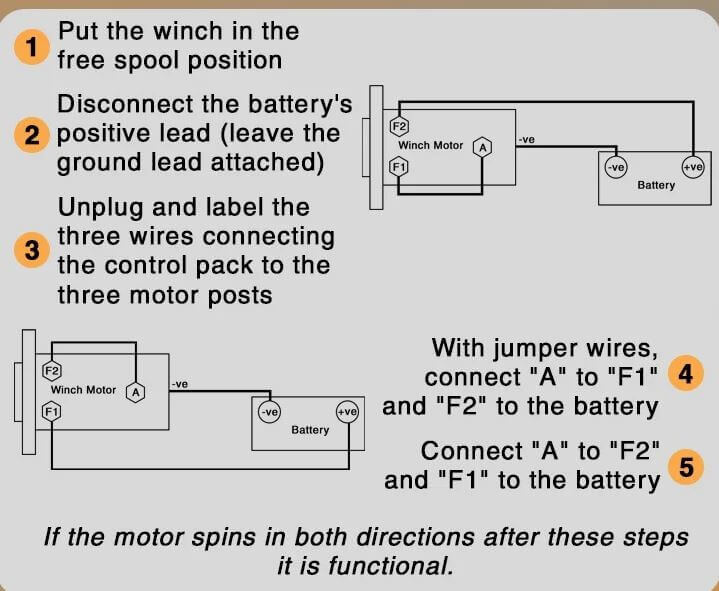
Stage 1: Get A Clear Picture of The Solenoid
Working without proper information about what you are to do is totally against work ethics and, in a case like this, will make the whole process more difficult. The purpose of the winch solenoid wiring diagram is for you to go through it and acquire sufficient knowledge of the terminals along with the cables in use.
Stage 2: Free Spool Mode
Free spool mode is likened to shifting your car into neutral gear before attempting to fix any issues with it. The winch is positioned in a free spool mode using the knob assigned for it. All loads attached to the winch at the time should be removed to prevent any occurrence of an accident.
Stage 3: Unplug the Battery Terminals
A pair of spanners or pliers are used at this stage. The battery terminals of the motor are disconnected, starting with the positive head. However, do leave the ground head plugged in to enable the winch to run. Unplug the three wires that connect the control pack to the three motor posts. Check for labels, and if there are none, you can label them accordingly as “A,” “F1”, and “F2”.
However, when observing the wiring diagram, you’ll realize that there are labels for the cables you need to work with. Also, mark the three ports on the motor to prevent any confusion in the connection process.
Stage 4: Connect the Jumper Wires
Using the jumper wires, preferably 5-6 inches dead lead cable, connect “A” to the “F1” & “F2” to the winch battery. To determine if you have successfully completed this stage, the winch motor will begin to run in a particular direction.
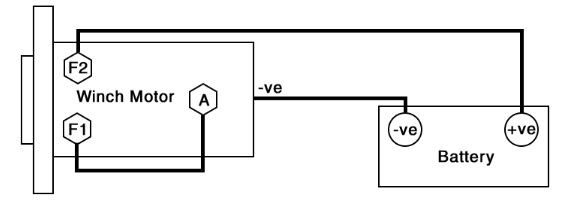
Stage 5: Test the Other End
Testing the other end is simply doing the alternative of step 4. You will connect “A” to “F2” with the jumper wire and link up “F1” to its battery. If successfully done, the winch motor should be moving in the opposite direction.
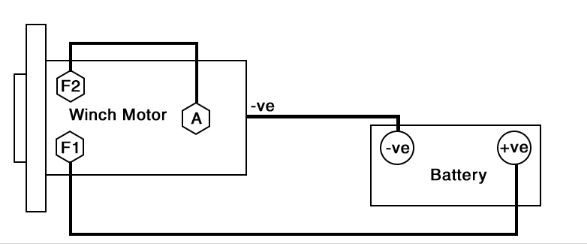
Final Thoughts
Winches are undoubtedly parts of your vehicle you cannot do without in emergency cases, but we can certainly say that this savior sometimes needs saving. The solenoid is an electromagnetic switch featured in new age winches, and easy as they were installed, they can be bypassed.
Now that you know how to bypass winch solenoid, it will be much easier to fix the minor issues with the motor or the battery by yourself.
The process requires technicality and can be tricky without proper guidelines to follow, so it’s advisable to seek help from professionals when performing the solenoid alternative process.
Recent Posts
It’s relatively easier when you’re buying a brand-new winch as you can choose one with cable or rope pre-installed. But when you’re planning on replacing the current cable winch, you will...
Getting your winch cable snapped in the middle of nowhere is not an uncommon thing. If you’re not ready for such situations in prior, you won’t have an escape from there. So, knowing a few...
